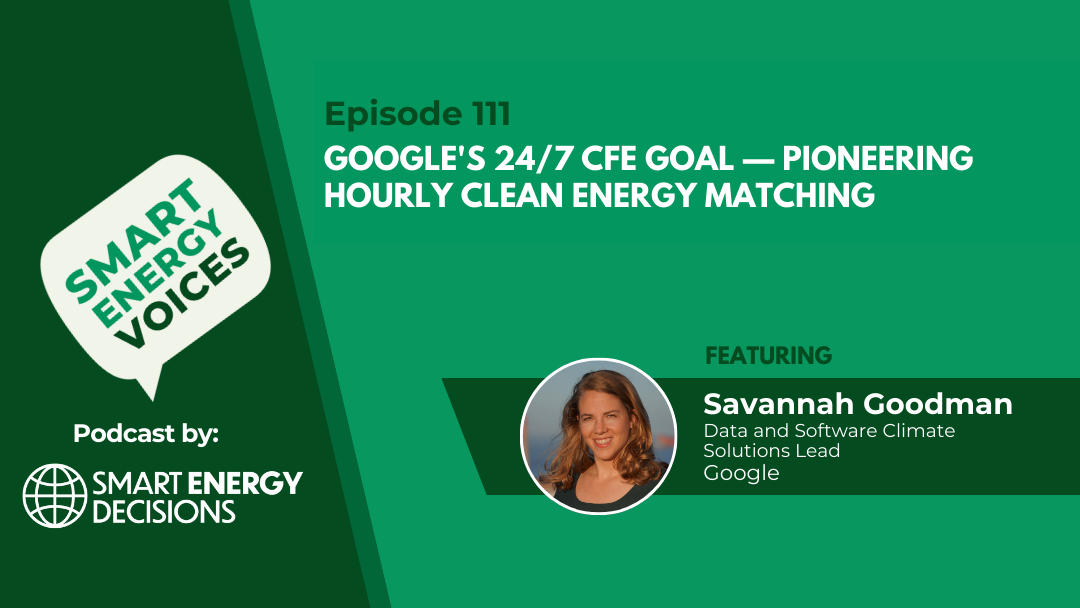Smart Energy Voices - Episode 111
Episode 111: Google’s Climate Journey – Decarbonization Within Reach
Listen on your Preferred Podcast Player »
In this episode of Smart Energy Voices, Savannah Goodman, Data and Software Climate Solutions Lead at Google, talks about Google's ambitious 24/7 carbon-free energy goal and the innovative tools Google is developing to decarbonize not only its operations but also to influence the broader energy grid. She reveals their use of Time-Based Energy Attribute Certificates (T-EACs) and how this technology can change the procurement of energy across all industries and deliver clean energy to the grid in times and places where it’s needed.
You will want to hear this episode if you are interested in...
- Google’s commitment to using 24/7 carbon-free energy (02:19)
- Google’s Time-Based Energy Attribute Certificates (T-EACs) (05:54)
- Load flexibility and demand response solutions at Google (09:15)
- Impact of smart energy programs on small companies (11:20)
- Broader net-zero goals by 2030 (13:02)
The 24/7 Carbon-Free Energy Goal
Google's 24/7 CFE goal is straightforward — to match its electricity consumption with carbon-free electricity in every grid where it operates, for every hour of the day by 2030.
This goes beyond offsetting annual energy use with renewable energy credits — it also aims to ensure that Google's energy use is truly clean at all times, regardless of location or time of day.
Time-Based Energy Attribute Certificates (T-EACs)
To achieve its 24/7 CFE goal, Google needed a tool to verify its clean energy matching claims on an hourly and local basis, which led to the creation and implementation of Time-Based Energy Attribute Certificates (T-EACs).
Google collaborated with registry M-RETS and software provider FlexiDAO to pilot T-EACs for their operations, starting in Denmark, Ireland, and the Netherlands. They also worked with EnergyTag to create the first international standard for hourly energy matching.
T-EACs can incentivize energy purchases that add new clean energy to the grid when and where it's needed most, while improving transparency into the clean energy market.
Google’s Load Flexibility and Demand Response
Another solution Google has implemented is load flexibility and demand response in data centers. Through this approach, Google is reducing its own carbon emissions and making the grid more efficient and reliable by moving computing tasks and energy use to times when carbon-free energy is available.
Savannah wishes for wider participation in demand response programs and encourages other data center companies, whether industrial or commercial, to adopt similar practices.
Google's Net Zero Goal
While continuing to focus on achieving its 24/7 CFE goal, Google is also working toward reaching net zero emissions by 2030, including cutting down on emissions across its whole value chain, supply chain and operations.
Google and all corporations stand to gain from a cleaner, more sustainable future, which the tech giant is helping to create. Every day, more and more businesses are joining the movement to make carbon-free energy more accessible.
Connect with Savannah Goodman
Savannah Goodman leads the team that incubates data and software solutions to enable Google and our partners to meet ambitious climate targets, including Net Zero and 24/7 Carbon-free energy by 2030. Her ultimate goal is to accelerate system-level grid decarbonization. In addition to incubating new solutions, her team spearheads technical ecosystem development and thought leadership, as well as drives strategic direction and expertise across Google.
- Smart Energy Decisions
-
Follow us on LinkedIn
Subscribe to Smart Energy Voices on
If you're interested in participating in the next Smart Energy Decisions Event, visit smartenergydecisions.com or email our Community Development team at [email protected]
Apple Podcasts, Google Podcasts, Android, Spotify, Stitcher, TuneIn Radio, aCast, PlayerFM, iHeart Radio











